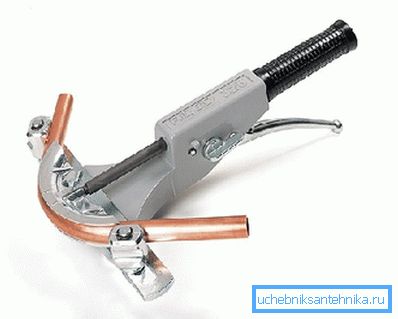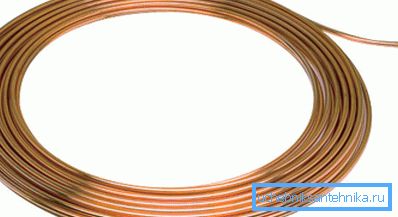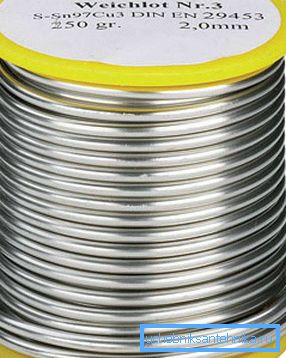Copper tube - current regulations and installation details
A man began to make copper pipes soon after he learned how to smelt copper itself. For several hundred years this material has faithfully served in everyday life and various industries. At this point in our state, a copper pipe is produced in accordance with GOST 617 2006, the creators of which tried to adapt this normative document as much as possible to their European counterparts.

Product Specifications
Copper is not only an expensive material, the price of which can be many times higher than the usual polymers, but also a very flexible and high-quality material, the durability and unique characteristics of which easily compensate for the initial investment.
All working moments associated with the rationing and standardization of copper products are fixed in GOST 617. For the first time this document appeared at the dawn of the Soviet power, namely in 1919, it is known to us as GOST 617 19. Since those times, with enviable consistency, about 1 Once a decade, these standards are constantly updated.

But all these standards were developed for the great and mighty former Soviet Union, whose metrological system was somewhat different from the European one. Therefore, the last one that appeared at the alliance with GOST 617 90 for copper pipes in the new era of market relations no longer corresponded to time. As a result, the above-mentioned 2006 standard was created.
Important: many of these standards have not lost their relevance to this day. Indeed, from the radical changes, in the last document, we can call the transition from calculus in inches to marking in millimeters. Otherwise, all updates, for the most part related exclusively to the increase in the range of products.

Material advantages
- This material is able to successfully resist corrosion, with the result that leading manufacturers give a guarantee for this product from 80 years and more. For example, the highest quality plastic promises to serve up to 50 years.
- Unlike PVC and some other polymers, such structures are not afraid of exposure to ultraviolet radiation.
- Of the materials used, this metal has perhaps the widest temperature amplitude in operation.. It feels good both at -200? C, and at +200? C, while the polymers are kept from -15? C to +140? C.
Important: the upper, positive limit of operation depends on the melting point of the solder, which was used for soldering joints and can reach +700? С.

- Structures with wall thickness up to 2 mm, traditionally used for plumbing and heating systems, are capable of withstanding an internal pressure of up to 54 atm, against a maximum of 25 atm for reinforced plastic.
- Due to the unique characteristics of the ductility of the pipe, you can easily bend yourself. Plus, thanks to the same plasticity, a unique in its kind copper corrugated tube is produced.
- In the plumbing and heating systems, water is chlorinated; from prolonged contact with chlorine, steel becomes unusable. Copper is covered with an oxide film and can serve indefinitely.
- This metal has a bactericidal effect, this indicator is not as high as that of silver, but it is sufficient that the pipes do not overgrow with mold.

Let's talk about the shortcomings
- All competitors are unanimous in stating that the price of the material is very high, but children and grandchildren will thank you for such a layout.
- The second thing that opponents point to is the high weight of the copper pipe. Indeed, the density of the material is 8920kg / m?, Against the maximum 7900kg / m? have become. So a half-inch steel pipe with a wall of 1 mm will be 12% lighter.
But for the plumbing there is enough wall 0.8 mm, as a result, the weight is equalized. Plus, the cost of a copper tube per meter, with a wall of 0.8 mm will be much lower.
Some moments of installation
For the installation of wiring is sometimes important load on the load-bearing structures. It is easiest to find out the weight of a copper pipe from the tables of the assortment according to GOST or use the online calculator.
But if these two methods are not available, then you can calculate it manually. To do this, you will need to know how many m2 of copper pipe in a specific meter segment of the product.

After that, it will be necessary to multiply the square of the walls of the structure in square meters, by the wall thickness in mm and by the specific weight of the metal equal to 8920 kg / m ?. Such calculations can not boast of great accuracy, so they are resorted to only as a last resort.
Traditionally, in most cases, such wiring is mounted by soldering using a gas torch. Copper pipes are also being repaired. The most convenient way is to solder with ordinary tin solder, the instruction is simple, the pipe needs to be cut exactly with a special pipe cutter, and the chamfer should be removed with a face scraper.
Next, one end of the pipe is stretched by a pipe expander to a depth exceeding the diameter of the product. Joint clearance is within 0.025 mm.

After that, the surface of the product is cleaned, treated with flux and connected. The soldering process is carried out by heating the joint to a temperature exceeding the melting point of the solder. Professionals advise not to heat the solder, it should melt from contact with the pipe, so due to the capillary effect the melted solder will fill the gap between the pipes.
In addition to soldering, a crimping method can be used, one of the variants of which is shown on the video in this article. But such a connection is not considered reliable, it is not recommended to wall it into walls or to use it in pressure structures with high pressure. Plus, if you put too much effort, you can damage the pipe.

It is also worth mentioning that the products are annealed and not annealed. In the process of producing a seamless rolled pipe, due to the cold deformation of the metal, the structure of the material changes and it loses its elasticity. To restore these characteristics of the design, they “release”, the tempering process involves heating to 700? С and gradual cooling.
Important: not annealed pipes are also used, but only in constructions with a straight pipeline, as it is impossible to bend such products, they will simply begin to crack and break.

The video in this article more broadly shows some points in the use of copper pipes.
Conclusion
The cost of a copper pipe per meter at a glance may scare. But the quality and durability of these structures have already been tested by time. Suffice it to recall that in a stingy and prudent Europe most of the buildings are equipped with these very structures.
